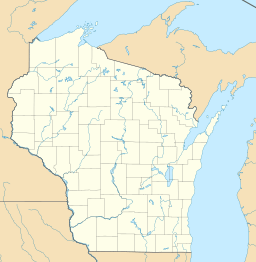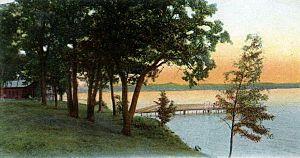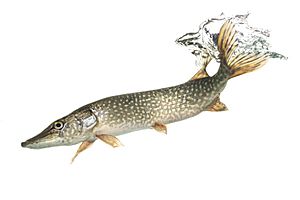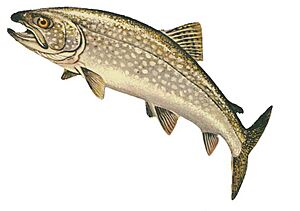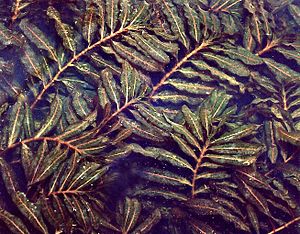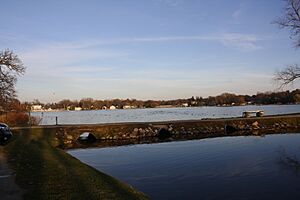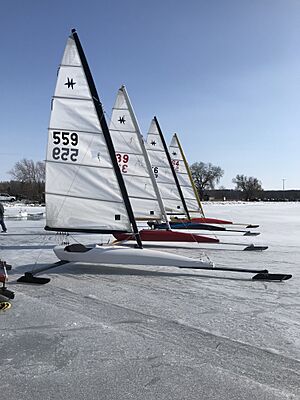Green Lake (Wisconsin) facts for kids
Quick facts for kids Green Lake |
|
|---|---|
| Big Green Lake | |
 |
|
|
Hydrographic Map of Green Lake Wisconsin
|
|
| Location | Green Lake County, Wisconsin, United States |
| Coordinates | 43°49′28″N 88°57′52″W / 43.82444°N 88.96444°W |
| Type | Dimictic |
| Etymology | Green appearance of the water |
| Part of | Big Green Lake Watershed |
| Primary inflows | Silver Creek,
White Creek, Dakin Creek, Hill Creek, Wurches Creek, Roy Creek, Spring Creek, Assembly Creek |
| Primary outflows | Puchyan River |
| Catchment area | 277.9 km2 (107.3 sq mi) |
| Basin countries | United States |
| Managing agency | Green Lake Association, Green Lake Sanitary District |
| Max. length | 11.75 km (7.30 mi) |
| Max. width | 3.219 km (2.000 mi) |
| Surface area | 2,973 ha (7,350 acres) |
| Average depth | 30.48 m (100.0 ft) |
| Max. depth | 72.24 m (237.0 ft) |
| Water volume | 0.9390 km3 (761,300 acre⋅ft) |
| Residence time | 21 years |
| Salinity | 502.80 - 532.88 uS/cm |
| Shore length1 | 43.94 km (27.30 mi) |
| Surface elevation | 242.3 m (795 ft) |
| Max. temperature | 27.2 °C (81.0 °F) Highest average, 2018 |
| Frozen | 87 days |
| Settlements | Green Lake, Wisconsin |
| 1 Shore length is not a well-defined measure. | |
Green Lake, also known as Big Green Lake, is a beautiful lake in Green Lake County, Wisconsin, United States. It's called "Big Green Lake" to tell it apart from Little Green Lake nearby. Green Lake is super deep, reaching 237 ft (72 m) at its deepest point. This makes it the deepest natural inland lake in Wisconsin! It's also the second largest lake in the state by how much water it holds. The lake covers about 29.72 km2 (7,340 acres) and has an average depth of 30.48 m (100.0 ft). Its shoreline stretches for 43.94 km (27.30 mi), with different types of land, from rocky cliffs to marshy areas.
Contents
- Green Lake's Past: A Look at Its History
- Where is Green Lake?
- How Green Lake Was Formed
- How Water Moves in Green Lake
- Water Quality and Chemistry
- Plants and Animals of Green Lake
- Green Lake's Ecosystem
- Environmental Concerns for Green Lake
- Protecting and Managing Green Lake
- Fun Things to Do at Green Lake
- Green Lake in Pop Culture
Green Lake's Past: A Look at Its History
Who Lived Here First?
The Ho-Chunk Nation of Wisconsin, also known as the Winnebago people, were the first to live in the Green Lake area. They called Green Lake "Daycholah" and saw it as a very special, spiritual place. One of their old stories says you need to bring gifts for the Water Spirit to enter the lake.
As more European settlers arrived, the United States government forced the Winnebago people to move many times. They were moved from Green Lake to Iowa, and later to a reservation in Minnesota.
Chief Highknocker's Story
Chief Highknocker was the last leader of the Winnebago people in the Green Lake area. He was born in 1820 and his real name was Henaga. He spent most of his life near the lake. But as more settlers came, he had to move further north. Even so, he kept visiting Green Lake every summer with his tribe members.
On August 12, 1911, when he was 91 years old, he sadly drowned in the lake after getting a cramp while swimming. Today, a large boulder marks his grave at Dartford Cemetery, with a special message from the community.
European Settlers Arrive
French settlers first called the lake Lac Verde, which means "Green Lake." In 1836, people could buy land in Wisconsin for $1.25 per acre. A man named Anson Dart, along with Smith Fowler and his son, built a dam to make the lake level higher. This led to the town of Dartford being named after him. Today, Dartford is known as the city of Green Lake.
The next year, Dart built a sawmill that used the water power from the dam. The dam helped raise the lake's water level, which allowed more mills to be built around Green Lake. In the late 1800s, many big wooden hotels and even a short-lived casino were built on the north shore in the city of Green Lake. Most of these old buildings have since burned down. The name "Green Lake" comes from the green color of its deep waters. The city of Green Lake is located on the northeast shore in Dartford Bay.
Lone Tree Farm's History
The land near the lake was perfect for farming. In 1888, Victor and Jessie Lawson bought a piece of land called Lone Tree Point. This land later became Lone Tree Farm. Victor Lawson was a newspaper editor and helped many charities. His wife, Jessie, was the main person who planned their large estate.
Together, the Lawsons developed about 1,100 acres of land. This land is still used today as a religious conference center. Some cool features of their estate included roads, a boathouse, and what was then the biggest dairy barn in Wisconsin!
Where is Green Lake?
The City of Green Lake has about 828 people (as of 2018). It sits on the northeast shore where the Puchyan River flows out of the lake. There are six public parks and lands on or near the lake. These include Sunset Park, Daycholah Lookout, and Hattie Sherwood Park.
Green Lake also has three beaches: Hattie Sherwood Beach, Dodge Country Park Beach, and Sunset County Park. You can find eight public boat ramps to launch your boat onto Green Lake.
Green Lake is part of a larger area called the Big Green Lake drainage basin. This area covers parts of three counties. Most of it is in Green Lake County, but small parts are in Winnebago and Fond Du Lac counties. This basin is also part of the Upper Fox River basin, which eventually connects to the Great Lakes.
South of Green Lake, you'll find three smaller lakes: Spring Lake and Twin Lakes. These lakes flow into Green Lake.
Green Lake has many interesting shapes along its shore, like bays, coves, points, and peninsulas. On the northern shore, from west to east, you'll find Beyers Cove, Sugar Loaf (a peninsula with a tall cliff), Norwegian Bay, Pigeon Cove, Malcolm Bay, and Dartford Bay. The City of Green Lake is around Dartford Bay.
Along the southern shore, from west to east, there's Blackbird Point, Dickinson Bay, Sandstone Bay, and Sandstone Bluff.
How Green Lake Was Formed
The Green Lake area was carved out by a river long before the Wisconsin glaciation (a time when glaciers covered much of Wisconsin). It's likely that the moving glacier also made the valley deeper and smoother. The valley eventually filled with water when a large recessional moraine (a hill of rock and dirt left by a melting glacier) blocked the water's exit. This moraine was about 90 m (300 ft) high!
The land around the lake is covered in drumlins. These are long, oval-shaped hills that were also formed by glaciers. They are covered in a thin layer of glacial till, which is mostly sand from the area's natural sandstone.
The dam at the Puchyan River has raised the lake's water level. This has created many new beaches. The type of material on the shore affects how quickly these beaches form. Areas with loose dirt erode faster than rocky sections. In older areas, large boulders protect the shore from erosion.
How Water Moves in Green Lake
Green Lake is 72.24 m (237.0 ft) deep and holds 0.9390 km3 (761,300 acre⋅ft) of water. This makes it the deepest natural inland lake in Wisconsin and the second largest by volume. Only Wazee Lake, which is man-made, is deeper. And only Lake Winnebago holds more water. The deepest part of Green Lake is near its west end, while the eastern part is shallower.
The Big Green Lake Watershed, the area that drains water into the lake, covers 277.9 km2 (107.3 sq mi). Most of this area is in Green Lake County.
Water Sources and Outflow
Where does Green Lake's water come from? About 51% comes directly from rain. About 41% comes from surface water, like creeks. And about 8% comes from groundwater.
Eight creeks flow into Green Lake. The biggest one is Silver Creek, which enters the east end of the lake. The other seven creeks are Hill Creek, White Creek, Dakin Creek, Wurches Creek, Roy Creek, Spring Creek, and Assembly Creek.
The main river flowing out of Green Lake is the Puchyan River. This river flows into the upper Fox River, which then goes into Lake Michigan. This means Green Lake is a "drainage lake," where most of its water leaves through a river. A dam at the river's start keeps the lake's water level about 1.52 m (5.0 ft) higher than it would be naturally.
Water stays in Green Lake for about 21 years before it flows out. This is a long time for a lake its size. This long "retention time" means that if the lake's water quality changes, it takes a long time for it to get back to normal.
Water Quality and Chemistry
Water Temperature
In 2018, the highest average temperature recorded in Green Lake was 27.2 °C (81.0 °F). The lake is usually covered in ice for about 87 days each winter. However, Green Lake has lost over 25 days of ice cover since 1940. If this continues, the lake might not have any ice cover by the year 2087.
Oxygen Levels in the Lake
Dissolved oxygen (DO) is super important for the health of all living things in the water. It's like the air we breathe for fish and other aquatic animals. If there isn't enough oxygen, these creatures can't live well or might even die.
In Green Lake, the amount of oxygen changes with depth. It decreases as you go deeper into the lake. One interesting thing about Green Lake is that it has a "metalimnetic oxygen minimum." This means there's a spot around 10 m (33 ft) deep where the oxygen drops a lot, from about 9 mg/L to 4 mg/L. Scientists think this happens because a lot of tiny organisms (plankton) are using up the oxygen there.
Because the oxygen level in this band is less than 5 mg/L, the Wisconsin DNR (Department of Natural Resources) said the lake was "impaired" in 2014. Low oxygen levels can be dangerous for fish and other animals that need oxygen.
Another concern is that oxygen is being used up faster in the deep parts of the lake than it was in 1950. This is because more nutrients, like nitrogen and phosphorus, are getting into the lake. These nutrients make more tiny organisms grow. When these organisms die and sink, they use up oxygen as they break down.
Nitrogen and Phosphorus: Key Nutrients
Nitrogen and phosphorus are important nutrients for all living things. They are found in many things, including animal waste and fertilizers used on farms. The area around Green Lake has a lot of farms, so these nutrients can easily wash into the lake.
Too much phosphorus is a big problem for Green Lake's health. If phosphorus levels go up, it can cause too much algae to grow, which makes the water quality worse. While the lake's average phosphorus level is currently just under the "impaired" level, it's likely still a concern. More phosphorus is probably causing the low oxygen levels mentioned earlier.
Since most of the creeks flow into the east end of the lake, phosphorus levels have generally been higher there. Efforts are being made to control how much phosphorus enters the lake by managing erosion, runoff, and fertilizer use.
Plants and Animals of Green Lake
Aquatic Plants
Green Lake is home to many different kinds of aquatic plants. Here are some of the plants found in the lake:
- Emergent Plants (grow out of the water):
* Bristly sedge * Stiff arrowhead * Hardstem bulrush * Softstem Bulrush * Common bur-reed * Cattail * Needle spikerush
- Floating Plants (float on the surface):
* White water lily
- Submerged Plants (grow completely underwater):
* Coontail * Muskgrass * Aquatic moss * Common waterweed * Water stargrass * Northern watermilfoil * Slender Naiad * Stoneworts * Slender Pondweed * Leafy pondweed * Fries' pondweed * Illinois pondweed * Longleaf pondweed * White-stem Pondweed * Clasping-leaf pondweed * Stiff pondweed * Flatstem pondweed * White water crowfoot * Spiral ditchgrass * Sago Pondweed * Wild celery * Horned pondweed
The most common native plants in Green Lake are Coontail (53%), Sago pondweed (15%), Wild celery (13%), and White water-crowfoot (12%).
Fish Species in Green Lake
Green Lake is a popular spot for fishing! Because it's so deep, it has both warm-water and cold-water fish. However, warm-water fish are more common. About 40 different types of fish have been found in Green Lake.
Common Warm-water Fish
- Largemouth bass
- Smallmouth bass
- Walleye
- Northern pike
- White bass
- Channel catfish
- Bluegill
- Black crappie
- White crappie
- Yellow perch
- Rock bass
- Muskellunge (these are added to the lake by people)
- Common carp
Cold-water Fish
- Cisco
- Lake trout (these are added to the lake by people)
- Splake
- Brook trout
- Brown trout
- Rainbow trout
Green Lake's Ecosystem
Warm-water Fish Life Cycle and Habitat
Both smallmouth and largemouth bass reproduce naturally in the lake and have healthy populations. Largemouth bass can struggle if their plant habitats are lost. Smallmouth bass do well because they like the lake's rocky and steep bottom.
Walleye numbers are naturally low in Green Lake. Fishing, limited plant habitats, late spring warming, and other fish eating their eggs or young fish limit their population size. Northern pike also face challenges because their spawning (egg-laying) habitats are damaged by buildings, boats, and carp. Fishing also affects their numbers, so there are rules about how many you can catch.
Panfish (like bluegill and crappie) have healthy populations. But fishing and building along the shoreline are threats. Losing woody plants along the shore is especially harmful to them.
Scientists also study fish that aren't usually caught for sport, like the blackchin shiner and Iowa darter. These fish are sensitive to changes in the environment, so they act as "indicator species." This means they help us know if the lake is healthy. Besides carp, other issues like shoreline development, boating, and too much algae can also affect fish habitats and growth.
Cold-water Fish Life Cycle and Habitat
Cisco are native to Green Lake and are often caught by anglers. They are very sensitive to environmental changes, and their populations go up and down. Recent studies show that the cisco population has slightly decreased. This might be due to eutrophication, which means the lake has too many nutrients. Climate change is also a big threat to cisco, and their numbers could drop a lot.
Lake trout are a very popular cold-water fish. The Wisconsin DNR adds 25,000 young lake trout to the lake every year. These fish are raised at a special facility near Green Lake. Sometimes, adult lake trout have scars, which might mean they've had conflicts with muskellunge where the warm and cold waters meet.
A major threat to cold-water fish is low oxygen, especially in the deep western part of the lake. The record for the largest lake trout caught in a Wisconsin inland lake was set in Green Lake on June 1, 1957. It weighed 35 lb 4 oz (16.0 kg)! The record cisco was also caught in Green Lake on June 12, 1969, weighing 4 lb 10.5 oz (2.11 kg).
Aquatic Plants and Algae Growth
Most aquatic plants in Green Lake grow at a depth of about 14 feet (4.27 m (14.0 ft)), with some growing as deep as 23 feet (7.01 m (23.0 ft)). Coontail and hybrid water milfoil are the most common plants. Coontail is a common plant in Wisconsin and can grow well even with little light because it gets most of its food from the water. It provides good homes for small water creatures and fish.
However, species like common carp and zebra mussels have caused problems for shallow water plants. High nutrient levels in the lake also lead to more algae growth, which can cause future problems for the lake's health.
Environmental Concerns for Green Lake
Pollution in the Lake
Before European settlers arrived, Green Lake was considered "oligotrophic." This means it had very few nutrients and excellent water quality. Now, Green Lake is considered a "mesotrophic lake." This means it has more nutrients, both from natural sources and from human activities. As a result, the water quality has gotten worse. The lake is now considered "impaired" by the Environmental Protection Agency because of its water quality.
Invasive Species: Unwanted Visitors
Invasive species are plants or animals that are not native to an area and can cause harm to the environment.
Invasive Plants
Two invasive plants, hybrid water milfoil and curly-leaf pondweed, have been in Green Lake since 1971. A survey in 2014 showed that hybrid water milfoil had become very common, making up 25% of the aquatic plants. Another invasive plant, the spiny naiad, was seen in 2007 but not in 2014.
- Eurasian water milfoil
- Hybrid water milfoil
- Curly-leaf pondweed
- Purple loosestrife
- Reed canary grass
Invasive Animals
Common carp have damaged plant species and fish spawning areas in the shallow parts of the lake. They've also affected Silver Creek and County K Marsh. Putting up barriers to block carp has helped plants grow back in Silver Creek. However, it hasn't worked as well in County K Marsh because too much phosphorus still enters that area from Silver Creek.
Both zebra mussels and Quagga mussels are also in the lake. These mussels help a green algae called Cladophora glomerata grow. This algae has been increasing since 1921 and is now causing problems. Too much Cladophora can help zebra and quagga mussel populations grow even more. It can also stop native fish from laying their eggs.
- (German) Common carp
- Zebra mussels
- Quagga mussels
- Freshwater Jellyfish
Protecting and Managing Green Lake
There are three main groups that work to manage and protect Green Lake: the Green Lake Association, the Green Lake Sanitary District, and the Green Lake Conservancy (also known as Green Lake Preservation Society).
Green Lake Conservancy's Role
The Green Lake Conservancy works to protect the land around Green Lake. They buy important natural areas, like woods or wetlands, and make sure they are preserved. They then work with the Wisconsin DNR and the Green Lake Sanitary District to manage these lands. So far, they have protected 15 properties around the lake.
Green Lake Association's Efforts
The Green Lake Association (GLA) started in 1951. It's a non-profit group with almost 800 families and businesses as members. Their main goal is to improve the water quality of the entire Big Green Lake drainage basin.
Fun Things to Do at Green Lake
Green Lake and the area around it offer many fun activities all year long!
In the summer, you can enjoy boating, water skiing, wakeboarding, tubing, swimming, sailing, jet skiing, kayaking, canoeing, paddleboarding, and fishing. The Green Lake Sailing School teaches sailing to all ages, and there are often sailboat races. The marina in Dartford Bay lets you easily get to town by boat.
Off the water, there are many bike trails, including "Loop the Lake," a 24-mile trail that goes all the way around the lake. The Green Lake Conservancy and Green Lake Sanitary District also have properties with public hiking trails. Green Lake also has several golf courses, including Tuscumbia Country Club, which is the oldest golf course in Wisconsin!
In the winter, the entire lake freezes over. You can go ice skating, hockey, ice fishing, snowmobiling, and iceboating on the ice. The Green Lake Yacht Club often hosts iceboat races.
Off the ice, you can go cross-country skiing, snowshoeing, and snowmobiling.
Green Lake in Pop Culture
- An episode of the Discovery Channel show A Haunting, called Legend Trippers, takes place in Green Lake and the nearby town of Montello.


